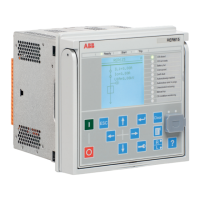5.4.4.3 Trigger detection
The fault distance estimate is obtained when SCEFRFLO is triggered. The triggering
method is defined with setting
Calculation Trg mode
. The options for selection
are: “External” or “Internal”, where the default value is “External”. The TRIGG_OUT
event indicates fault distance value recording moment. The fault distance estimate,
Flt distance, together with the timestamp of actual triggering are saved in the
recorded data of SCEFRFLO.
• In case of external triggering, an external trigger signal should be connected to
the TRIGG input. The triggering signal is typically a trip signal from a protective
function. At triggering moment the fault distance is stored into recorded data.
It is important that triggering is timed suitably to provide sufficient distance
estimation calculation time before tripping of the feeder circuit breaker.
• In case of internal triggering, the TRIGG input is not used for triggering. Instead,
the trigger signal is created internally so that the estimation is started when
phase selection logic detects a fault and the estimate is triggered when its value
has stabilized sufficiently. This is judged by maximum variation in fault distance
estimate and defined with setting
Distance estimate Va
(in the same unit as
the fault distance estimate). When successive estimates during one fundamental
cycle are within “final value ±
Distance estimate Va
”, the fault distance estimate
(mean of successive estimates) is recorded. In case stabilization criterion has not
been fulfilled, the fault distance estimate is given just before the phase currents
are interrupted. The phase selection logic is a non-directional function, and thus
internal triggering should not be used when directionality is required.
Generally, SCEFRFLO requires a minimum of two fundamental cycles of measuring
time after the fault occurrence.
Figure 259
illustrates typical behavior of fault
distance estimate of SCEFRFLO as a function of time.
• Immediately after the fault occurrence, the estimate is affected by initial fault
transients in voltages and currents.
• Approximately one fundamental cycle after the fault occurrence, the fault
distance estimate starts to approach the final value.
• Approximately two fundamental cycles after the fault occurrence, the stability
criterion for fault distance estimate is fulfilled and the TRIGG_OUT event is sent.
The recorded data values are stored at this moment.
1MRS758755 C
Protection related functions
REC615 & RER615
Technical Manual
513

